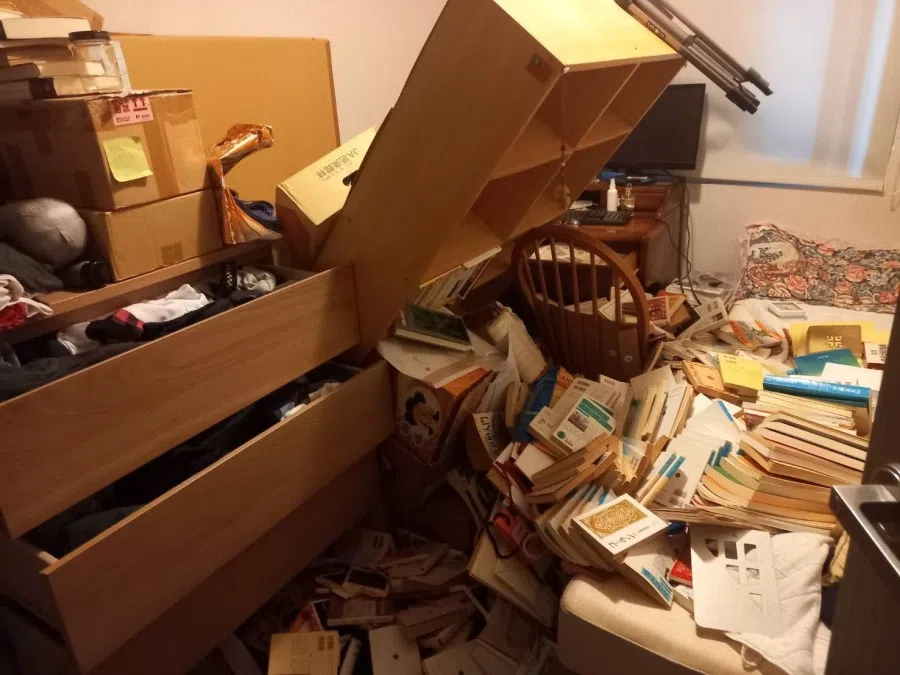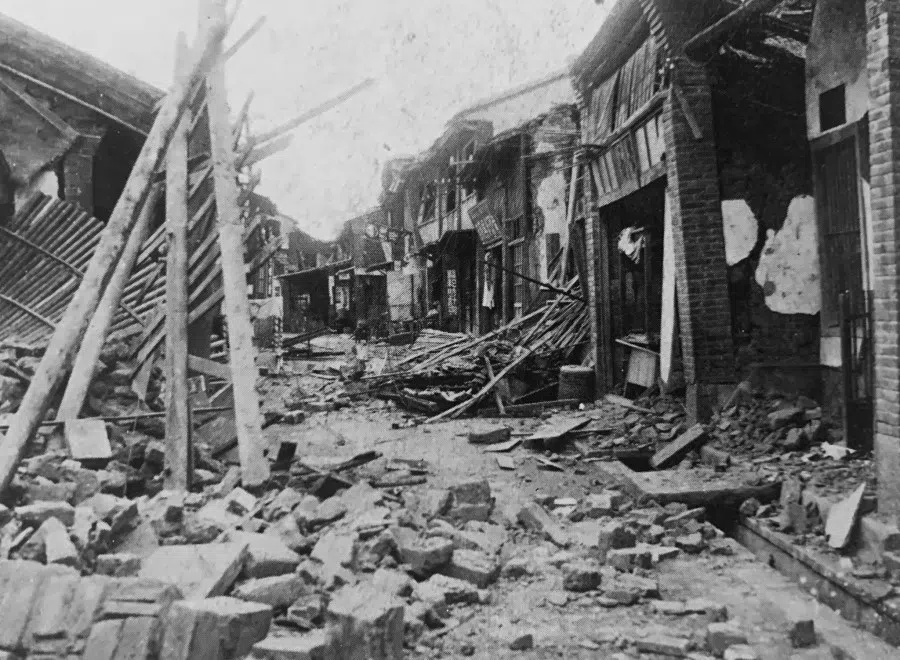[Photo story] How earthquakes have shaped Taiwan's collective psyche
The earthquake that hit Hualien in Taiwan on 3 April 2024 is just the latest in a long list of earthquakes in Taiwan's history, for example the 921 earthquake of 1999 and the earthquake of 1935 that hit Taichung. How have these earthquakes affected the people of Taiwan and shaped their psyche through the ages? Historical photo collector Hsu Chung-mao provides some insight.

(All photos courtesy of Hsu Chung-mao.)
Early in the morning of 3 April 2024, a major earthquake struck Taiwan. Being situated in an earthquake-prone zone, we have grown accustomed to frequent earthquakes since childhood.
It is a normal part of life to feel houses slightly shake, but this time the earthquake was particularly strong and lasted for a while, causing the items in our glass cabinet to fall out; it seemed like the house would collapse if the shaking did not stop. Generally, the higher the floor you live on, the stronger the shaking, and many neighbours in our apartment block instinctively ran outside.
Thousands of aftershocks
When the earthquake finally stopped, we quickly turned on the television and checked our phones. The news confirmed that it was an earthquake measuring 7.2 on the Richter scale, with the epicentre off the coast of Hualien - the hardest-hit area was Hualien city.
The news quickly spread overseas, and people around the world saw a terrifying apocalyptic scene of a collapsed building in Hualien amid clouds of smoke. Meanwhile, tremors were felt in Fujian, Luzon island and Okinawa, which even issued a tsunami warning.
In Taipei, given today's rapid development of mobile phone communications, friends were quick to share their experiences on Facebook. My Japanese friend Honda, who lives in Taipei, sent photos showing his collapsed bookshelves. He said, "Even the wine bottles fell and shattered on the floor."
... in terms of casualties and building collapses, the damage is much less severe than that of the "921 earthquake" of 1999.


My office got off relatively unscathed, with just fallen boxes of books and a wardrobe that shifted. As for daily life, since the earthquake occurred during rush hour, all subway services were suspended. Many passengers were trapped underground or on elevated bridges, leading to claustrophobia. Also, the week following a major earthquake would usually have thousands of aftershocks, some of which are still strong enough to be frightening.
The Hualien earthquake has caused at least 1,145 injuries, with 440 people trapped, and there are 16 deaths, all in Hualien, as of 10 April. However, in terms of casualties and building collapses, the damage is much less severe than that of the "921 earthquake" of 1999.
At around 1 am on 21 September 1999, a 7.3-magnitude earthquake struck Jiji (Chichi) township in Nantou county. The shaking lasted for about two minutes, and strong tremors were felt throughout Taiwan. Houses collapsed, with the worst affected areas being Nantou and Taichung counties. The final statistics were 2,415 deaths, 29 missing and 11,305 people injured; there were even families that could not escape in time and were tragically crushed to death in their homes.
At that time, there were no smartphones, so we could only listen to the news on the car radio, with severe situations reported from various places. It was late at night, and the atmosphere was tense. It felt like the end of the world.
Inevitable part of life
That was 25 years ago, and I still remember it vividly. At that time, my daughter was six years old, and my son was two-and-a-half years old. When the earthquake struck, the power immediately went out, and my wife and I quickly took the children downstairs in the dark. We hid inside our car that was parked by the apartment building.
At that time, there were no smartphones, so we could only listen to the news on the car radio, with severe situations reported from various places. It was late at night, and the atmosphere was tense. It felt like the end of the world.
However, some elderly people reacted differently. For example, my mother was unfazed and remained sleeping in her room upstairs. We stayed in the car downstairs for a couple of hours, and went home when the situation had somewhat stabilised.








The 921 earthquake also shocked the international community. Over the following month, various international rescue teams came to Taiwan to assist, having to rescue survivors buried in collapsed ruins within the critical 72-hour window. The earthquake was covered by the news around the clock every day. Details gradually emerged, including heartbreaking news of families being shattered, children and parents losing one another in an instant, spouses separated forever and entire families united in death under the rubble.
As for those who survived the collapsed buildings, they were temporarily housed in school auditoriums and received relief aid as disaster victims. This is an inevitable part of life for people living in earthquake-prone Taiwan. Such massive natural disasters certainly toughen up the people, making them more resilient and composed in the face of major changes.
Tests posed by the natural environment
In fact, the largest earthquake in Taiwan's history was the 7.1-magnitude earthquake of 21 April 1935, known as the Hsinchu-Taichung Earthquake, which caused a total of 15,255 casualties, including 3,279 deaths and 11,976 injuries. A total of 54,792 households were affected, including 17,927 homes that were completely destroyed, 11,446 partially destroyed, 9,836 severely damaged and 15,583 slightly damaged.
It is deemed the most devastating earthquake in Taiwan's history, where many people lost their loved ones and homes. Given that schools collapsed and teachers died, it took several years for society and the education system to gradually return to normal.
... the 1999 and 1935 earthquakes occurred under the mountains in central Taiwan, causing landslides and collapsed buildings and leading to severe casualties and damage.












Looking at the above statistics, some may wonder why the death toll and property damage differ so much despite the similar magnitudes of the three major earthquakes mentioned. In particular, why were the casualties and property damage relatively low in the 7.2-magnitude Hualien earthquake, which was of higher magnitude than the 1935 earthquake? There are two reasons.
First, the epicentre of the recent earthquake was under the sea off the coast of Hualien, which naturally reduced the impact on land; however, it was necessary to be alert to tsunamis triggered by undersea earthquakes. In contrast, the 1999 and 1935 earthquakes occurred under the mountains in central Taiwan, causing landslides and collapsed buildings and leading to severe casualties and damage.
Second, given years of experience, buildings are now constructed with earthquake proofing in mind, including considerations in architectural design, materials, spatial planning and earthquake evacuation. When earthquakes occur, the damage has naturally lessened. Today, collapsed buildings in earthquakes are not simply accepted as inevitable; instead, the quality of the original engineering design comes under review.
Local prosecutors investigate whether corners were cut, or if there was a failure to follow regulations during construction. For example, the collapsed building in Hualien was previously listed as "dangerous", so the focus would be why its renovation was continually delayed, or if there were bureaucratic issues or corruption involved.
In short, earthquakes are part of life in Taiwan, from childhood to adulthood. My earliest memory is when I was about six years old, when an earthquake occurred in the middle of the night. My parents woke me up and took me to the street to take refuge. It was a complete blackout, and many people were gathered on the dark streets, whispering to one another - that is my vague childhood memory of surviving an earthquake.
Over the following 50 years, there have been countless other earthquakes. In fact, besides earthquakes, typhoons in the summer and autumn are also major natural disasters in Taiwan.
Growing up in Taiwan amid earthquakes and typhoons, life is always about endless trials. However, in the face of the tests posed by the natural environment, we strive to be resilient and create the best life and home we can.





